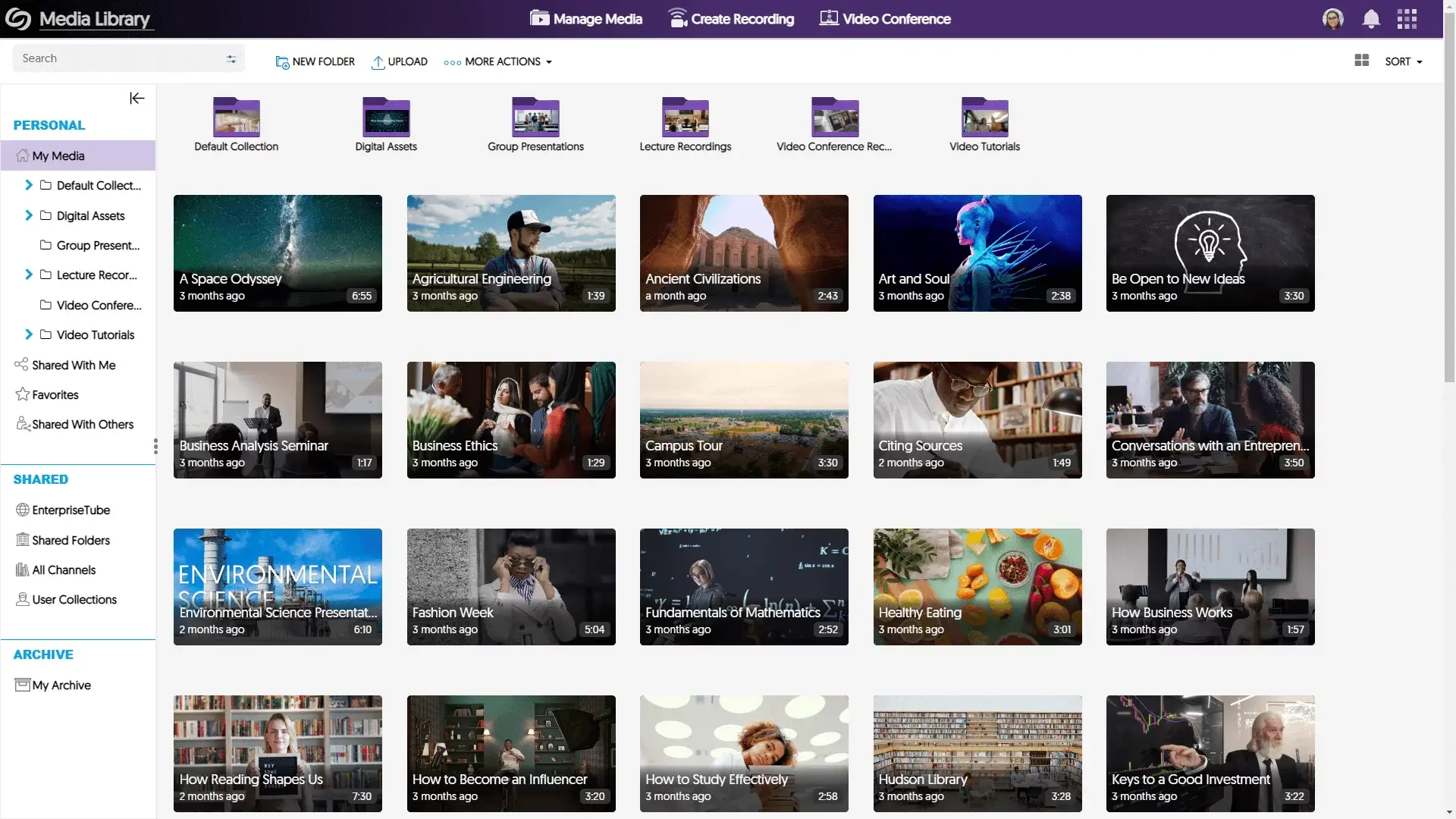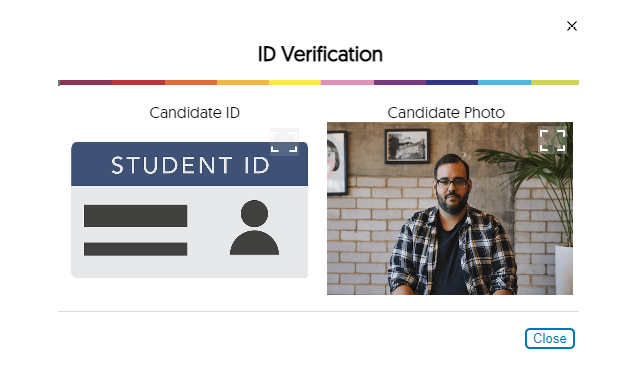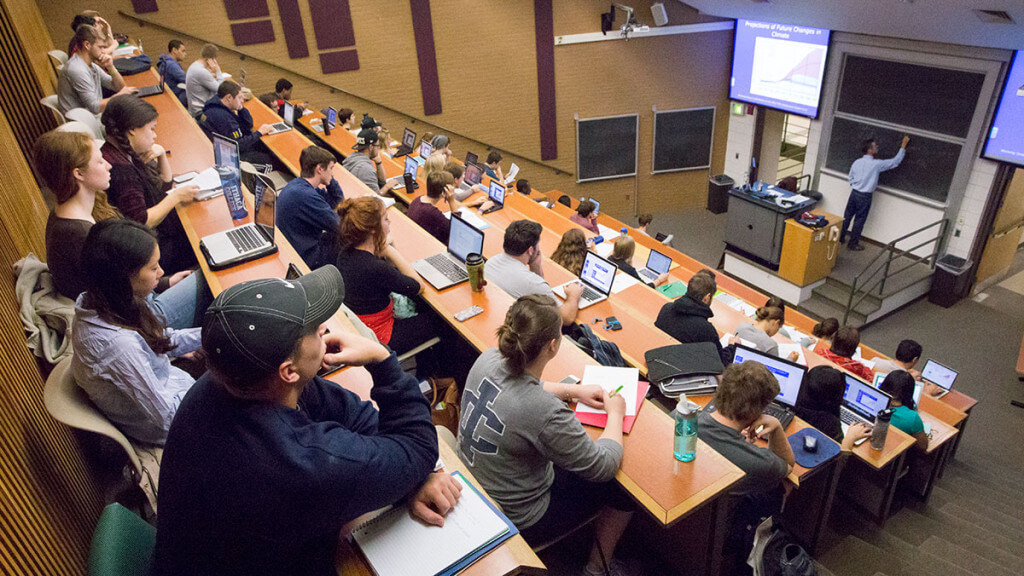8 Ways to Expand Video in Education Using the YuJa Video Platform
Video-based learning helps strengthen the knowledge transfer and makes distance-based learning more comprehensive and accessible to all. Video is effective as a stand-alone educational tool or as a supporting aid, making it an essential part of the learning process.
To help you use video more effectively, we’ve outlined some of the ways a video platform can benefit your institution.
VIDEO CONTENT MANAGEMENT
 With hundreds of hours of video and digital content being created, educational institutions need a way to manage and organize their media.
With hundreds of hours of video and digital content being created, educational institutions need a way to manage and organize their media.
A Video CMS (Content Management System) makes it easy to securely host and manage multiple types of content in the cloud. A Video CMS also can connect to your Learning Management System (LMS) to enable video within the LMS for lecture capture or online course deployment.
By centralizing all video and digital assets, it’s easier for students to locate and watch the specific content they need.
LECTURE CAPTURE
One of the most popular ways that video is utilized at educational institutions is lecture capture. Lecture capture systems make it possible to capture the full lecture experience. In other words, a lecture capture solution captures video of the instructor and any accompanying devices, such as a screen share or documents shared during the lecture.
Lecture capture should be able to be ad hoc or planned, making it easy for the instructor to initiate video, and should capture all types of devices, from a desktop computer to a laptop, tablet and even mobile phones.
FLIPPED CLASSROOM
In a flipped classroom, the lecture portion of the class takes place outside the classroom with the support of video. Instructors can record their lecture at home or in the classroom and share it with students for viewing anytime. No matter where instructors are recording, it should be easy for instructors to fire up a recording and pause when needed.
A flipped classroom also gives students easier access to help and likely leads to fewer frustrations among students when getting stuck. With more time available for human interaction, everyone wins. This opens up classroom time for discussions and the ability for students to complete work on the spot.
LIVE STREAMING
One way video can be used to connect with students is through the use of live streaming, which allows students to use a simple link to access live content via the Internet.
 It should be easy to initiate a live stream on the spot or as a planned event. Events should be private, giving access only to those with a customized URL to join the meeting. Live streaming might also be used when an instructor needs to live stream to a second classroom or location.
It should be easy to initiate a live stream on the spot or as a planned event. Events should be private, giving access only to those with a customized URL to join the meeting. Live streaming might also be used when an instructor needs to live stream to a second classroom or location.
Live streaming can also be used for music events, graduation, or campus-wide events that attract a large audience. It also allows those who can’t travel to the event the opportunity to view the event as if they were.
VIDEO ASSIGNMENTS AND STUDENT RECORDING
In the event an instructor wishes to assign homework that has a visual and auditory aspect to it, such as a student speech, video assignments are a great way to enable student recording, especially in distance-based learning environments.
Students can record their responses to an assignment from anywhere and upload it to an institution’s video CMS. For example, a nursing student might record a session with a mock patient that includes a sequence of tasks that need to be performed. Once the student has uploaded their video, instructors can review their videos to determine if they meet the assignment requirements.
STAFF TRAINING AND TUTORIALS
When instructors record their lectures for students, they can review their teaching style and self-reflect on areas of improvement.
Many colleges and universities are using video to create how-to and other training resources for faculty and staff. If the video is evergreen, it can be stored in your Video CMS and used indefinitely. If it needs changes, it can quickly be edited and reused.
When instructors record their lectures for students, they can review their teaching style and self-reflect on areas of improvement.
VIDEO ACCESSIBILITY AND CAPTIONING
The YuJa Cloud is a powerful video management platform that uses AI to categorize content, generate topic tags and headers through semantic analysis. Topics become searchable tags, making it simple for students to find relevant content to further their academic goals.
YuJa’s automatic captioning, video and audio transcriptions and Audio Descriptions help you to comply with the 21st Century Communications and Video Accessibility Act (CVAA). This act ensures that educational institutions use emerging technologies and communication channels to reach people with disabilities.
IN-VIDEO COMMENTING
In-Video Commenting allows both instructors and students to interact within media to share comments and questions to create an interactive, collaborative experience. To make it easy to view and respond to comments, they’re fully searchable in the Media Player, and viewers can see all comments in the video sidebar. YuJa’s Media Player effectively becomes an interactive video collaboration space with time-linked, in-video commenting that can also be used to make video quizzes and assessments more interactive.
Benefits of Online Test Proctoring in Higher Education
We’ve outlined some of the top benefits of online test proctoring in higher education.
Benefits for Institutions
Online Proctoring Software Verifies Identities
Identity verification is a key element in secure online testing, as institutions want to ensure the student receiving the credit is the one taking the test. Software tools like YuJa Verity make identity verification part of the process to ensure grades are being earned with integrity.
Online Test Proctoring Software is Scalable
Because there is no specialized hardware, online test proctoring can be rolled out anywhere. As the number of online, hybrid and hyflex courses increases, so does the need for an online test proctoring solution that affordably scales with the institution.
Benefits for Instructors
No Complicated Learning Curve for Instructors
Instructors have a lot on their plates without having to learn something new for remote test proctoring. With software that integrates directly with an institution’s LMS, instructors can create a quiz or test in their LMS as they normally would, edit their settings, and wait for students to take their assessments. Results are displayed in a central LTI app location.
“With software that integrates directly with an institution’s LMS, instructors can create a quiz or test in their LMS as they normally would, edit their settings, and wait for students to take their assessments.”
Analytics Provide In-Depth Reports on Testing Behaviors
With deep analytics, instructors can better understand current patterns and trends over time both for their course and for individual students. Instructors can use these reports to improve online testing success.
Benefits for Students
Online Proctoring Offers Flexibility to Test-Takers
Students can take tests online from the comfort of their own home or in a place that is familiar and comfortable. In addition, if those taking the test are professionals testing for certifications or licenses, or students with daytime obligations, they don’t have to take time off to travel to a testing center or worry about timing as long as the test is completed during a set timeframe.
Users Don’t Need Specialized Hardware
Users can take tests – including those conducted by third parties like Pearson-Vue, McGraw, ALEKS, and others – with a standard desktop, laptop, or tablet in a few simple steps. This helps make testing available to students no matter where they are in the country or world.
How to Get More Out of Your Lecture Capture Platform

We are all aware of this change; in fact, lecture capture solutions are already quite a mainstay in many learning institutions. In a survey conducted by Peter Reed, over 92% of students utilize lecture capture to clarify aspects of lectures that they are struggling with and 87% utilize them to prepare for upcoming exams. Distance-based learning accompanied by visual tools has made it more convenient for students to learn and continues to spread.
Here are five ways to make the most out of your lecture capture platform.
1. Flip Your Classroom
As one of the biggest education trends, the flipped classroom environment utilizes video to expose students to new materials outside of the classroom. Instructors have the luxury to record various lectures in or away from the classroom to share with their students for viewing at any time. According to a LearnDash study, 90% of instructors have noticed a positive change in student engagement since flipping their classrooms. The ability to record lectures anywhere allows for more class time to be focused around discussions and increased student engagement.
2. Enhance Your Presentations
The utilization of presentation software to share information with fellow classmates or colleagues remains ever-present. By being able to access your presentations from any device with the reduced risk of presentation difficulties, online presentations are a convenient way to share presentations both in person and through video. Whether you prefer Google Slides or Microsoft PowerPoint, your presentation skills can be showcased publicly or with a limited group of registered users.
3. Make Use of Student Recordings/Video Assignments
In the event that an instructor assigns homework involving visual and/or auditory requirements (e.g., student speeches), student recordings are a helpful tool to assist students in honing their presentation skills. Professors can assess student performance and provide feedback while students can continue to develop their presentation skills anywhere with any device. If you are studying law, business, or are in the sciences, video assignments can deliver instructional workflows for students that fit the needs of any subject or classroom structure.
“Professors can assess student performance and provide feedback while students can continue to develop their presentation skills anywhere with any device.”
4. Apply Social Learning
A positive environment that facilitates learning and growth requires many strategies to thrive whether you are dealing with a classroom or corporate setting. With your lecture capture platform, recorded lectures and presentations can be viewed at any time for instructors to improve on their teaching style and even distribute best practices among fellow instructors. Students can even share notes or study guides to prepare for upcoming assignments and exams. By providing staff and students with the necessary tools to effectively share knowledge, you can ultimately maximize efficiency and productivity.
5. Live Stream Your Lectures
Thanks to the advancement of technology, students are continuing to leverage live video to supplement their learning outside of the classroom. By leveraging the lecture capture’s live-streaming functionality, institutions have the ability to live stream events campus-wide and via the internet. Instructors can even host drop-in and small-scale live office hours within their LMS with nothing to download or install.
What Is Micro-Flipping in Education?
Micro-flipping uses short lectures, both in-and-out of the classroom setting, providing some of the benefits of a traditional classroom and some of the benefits of a flipped classroom. A micro-flipped class video will typically be five minutes or less in length.
The Benefits of the Micro-Flipping a Classroom
Micro-flipping works in both flipped and traditional classrooms, and can help to address some of the challenges found in each type of classroom. The time investment is minimal; instructors can create micro-flipped recordings in just a few minutes while sitting at their desks or even record them using mobile tools.
Micro-flipping in the Flipped Classroom
“The key to micro-flipping is to infuse technology (where warranted) with student engagement while intermittently peppering students with content in a lecture or conversation-style format. This gives students more autonomy in the learning process but also allows them to be guided as needed,” Sam Buemi, the author states.
One of the primary criticisms of flipped classroom structure is that the classroom is designed to function for students who have watched the lecture material ahead of time and who are motivated to learn. If instructors require work to be completed outside of the classroom, segments of students may not be successful. Instead of fully flipping the classroom, micro-flipping can benefit both those who are prepared and those who have not by blending flipped-classroom and traditional classroom approaches.
The Chronicle of Higher Education notes that a typical class will include short lectures and student engagement with materials, including activities like polls, mobile-app engagement, or group activities interspersed with snippets of lecture or teacher-led conservation.
Providing students with short video lectures ahead of class and offering some part of the lecture during classroom time caters to both high-achievers and less motivated students to make the flipped classroom function better for all students.
Micro-flipping in a Traditional Classroom
Micro-flipping can also offer benefits in a traditional classroom. In this case, the video made available before the class can act as a sort of preview for students of in-class content. This can encourage interest in the classroom lecture or provide additional thoughts or ideas related to classroom readings. Students who miss a class can also rely upon micro-flipping to catch up before the next class, even if full lecture capture recordings are available.
The Importance of Video Analytics
With video analytics, instructors and administrators can see who watched a video, review video hotspots, and see how long each viewer spent watching different videos. A powerful analytics suite is a key component to a Video Content Management System (VCMS), as it can draw attention to what media is making an impact and how it’s performing.
YuJa’s Enterprise Video Platform offers a variety of information about individual media files and how users interact with those files. The overall summary shows information on storage, views, viewing patterns and where users stop watching the video, providing instructors with insights on areas where students may be having trouble.

Using Analytics to Improve Play Rate
Your play rate is how often viewers play video content. A low play rate means your investment in video content will be ineffective, and your students, clients and customers won’t learn as much as they could from your videos.
Increase your play rate by:
- Choosing visually interesting thumbnails. The thumbnail is the first thing a viewer sees, so it’s important to make this image as compelling as possible. Granted, students might not have a choice but to view the video, but user experience will impact how much of the video is viewed and how the overall course is perceived by students.
- Selecting a high quality media player. Make sure students can view your video no matter their device with a responsive video player that provides high-quality video on demand. Things like adaptive bitrate streaming, network-sensing technology and interactive capabilities make high-def streaming a positive experience for all.
- Keeping video content front and center on your site. Placement matters, so make sure your videos and assets are in the right place for the right audience to optimize play rate.
Assessing Video Engagement
Video engagement is how much time people spend watching your video content, and how much they engage with content, whether it’s by asking or answering questions, taking notes, or adding annotations. A higher video engagement means that viewers are staying interested in your content rather than shutting off the video mid-play.
Analytics enable administrators to look closely at individual videos. This can, over time, enable pattern recognition in videos and overall improvement of video content and video engagement. Assessing the following may help to improve video engagement.
- Are viewers watching videos all the way through? If not, when are they stopping the video? Are there any patterns to viewer interest?
- Is the video topically appropriate for the site? Is it relevant to your viewers?
- Does the video meet the needs of your users? Do they have a reason to watch it?
- Which of your videos has performed the best? What has made it a strong performer?
Not only does YuJa’s analytics suite provide an overall summary of data, but it also breaks it down user by user, which allows instructors to identify at-risk students.

Using YuJa’s Video Analytics
Using video analytics maximizes the value of video content and video content management. YuJa’s Usage and Analytics tools enable an in-depth understanding of how users are watching video, and how your videos are performing on an ongoing basis. With these tools, you can review how students are using your content, what is peaking their interests, and which videos are performing best, which can be used to help guide future lessons.
The Leading Alternative to VidGrid Chosen By the Majority of Former VidGrid Customers
Benefits of Migrating to YuJa Enterprise Video Platform
YuJa empowers learning enterprises to create engaging educational experiences. “Switching technology solutions doesn’t have to be a burden. Our experienced implementation and support teams understand all the logistics and can help create a seamless transition for the institution and students alike,” said Nathan Arora, Chief Business Officer at YuJa Inc. “YuJa is an innovative, robust, affordable alternative to VidGrid for educational enterprises.”
All-in-One Platform
YuJa’s Enterprise Video Platform is an all-in-one solution that empowers instructors and course designers to securely create, manage, discover, collaborate and stream accessible content across devices.
“Switching technology solutions doesn’t have to be a burden. Our experienced implementation and support teams understand all the logistics and can help create a seamless transition for the institution and students alike,” said Nathan Arora, Chief Business Officer at YuJa Inc. “YuJa is an innovative, robust, affordable alternative to VidGrid for educational enterprises.”
- It’s designed with institutions in mind, and quickly integrates with your LMS.
- The Media Platform is a comprehensive Video Content Management System (VCMS) that hosts video and digital media in a secure Cloud environment.
- YuJa facilitates flipped classroom and classroom capture, with hardware, software, browser and mobile capture options.
Consolidate Your Ed-Tech Tools
In addition to lecture capture, YuJa’s solutions enable consolidation of many ed-tech tools into one platform. Solutions include:
- Live Streaming
- Video Conferencing
- Test Proctoring
- Digital Accessibility,
- Archiving and Compliance
- Real-time audience response
 Support You Can Count On
Support You Can Count On
We pride ourselves on our second-to-none customer success, implementation and support teams. Customer service is always included with each deployment license, which includes live, total user customer service, dedicated account management staffing and consistent support, all backed by the team’s award-winning product engineering and operations teams.
Our Experience is Broad
YuJa has experience migrating hundreds of thousands of terabytes of video data from all competitors, including VidGrid. YuJa also has a highly-experienced Customer Success team that has performed migrations at scale, from start to finish, in a matter of weeks.
How YuJa Cloud Storage Meets Institutional Needs
YuJa Meets Institutional Needs
Video and media storage is a growing challenge for institutions of all sizes. Maintaining adequate on-site storage can be costly and challenging. The YuJa Cloud is a built-in, cloud-based storage that’s expandable, accessible, and works with existing tools and learning management systems.
 Elastic Architecture Facilitates Growth: The YuJa Cloud can grow with your institution’s media library, without the need for additional hardware or IT personnel.
Elastic Architecture Facilitates Growth: The YuJa Cloud can grow with your institution’s media library, without the need for additional hardware or IT personnel.- Security is a Priority: The YuJa Cloud is highly stable, fault-tolerant and secure, with multiple attestations and certifications. YuJa’s Video Platform is even certified as HIPAA compliant, ensuring even protected health information can be transmitted.
- The YuJa Cloud is Accessible Anywhere: Media content stored on the YuJa Cloud is accessible from anywhere, via a computer or mobile device. Administrators, instructors and students can easily adapt to accessing and using the YuJa Cloud for media storage.
- Integrations Make Importing Simple: The YuJa Cloud can be fully integrated with your LMS using LTI. YuJa also provides other, separate integrations, such as the Zoom Connector, which automatically imports Zoom recordings into the Video Platform without manual downloading or uploading.
To help institutions manage large workloads, identify compliance issues and create data retention policies, YuJa offers Himalayas for Enterprise Archiving, which is built in the cloud and meets SOC-2 Compliance standards.
University of Manitoba Hosts YuJa Video Contest

Lori Isber from the Centre for the Advancement of Teaching and Learning sits with prizes from the YuJa Video Contest. Photo by Joeffer Domingo.
When YuJa was deployed at the University of Manitoba in September 2021, a contest was launched the same day. Instructors and staff who used the YuJa Enterprise Video Platform within the first month were entered into a contest to win a prize that includes a UM tote bag and products from YuJa, Dell and D2L.
Entrants poured in, and winners have been announced.
“Wow, I never win anything,” said Dr. Juliana M. Marson when she found out she was a YuJa Video contest winner. The assistant professor at the Centre for Earth Observation Science can no longer claim to never win because she picked up her UM tote filled with prizes at The Centre for the Advancement of Teaching and Learning.
YuJa Video Platform prize winners came from faculties and units across UM including:
- Faculty of Science
- Asper School of Business
- Clayton H. Riddell Faculty of Environment, Earth, and Resources
- Faculty of Agriculture and Food Sciences
- Faculty of Arts
- Faculty of Kinesiology and Recreation Management
- Faculty of Law
- Max Rady College of Medicine
- Rady Faculty of Health Sciences
- Robson Hall Law School
- Vice Provost Teaching and Learning
- Libraries
- Faculty of Graduate Studies
- Extended Education
- Faculty of Education
Congratulations to all the winners!
This blog was adapted from the university’s news release. Check out the release here.
Make Your Organization’s Content Accessible Across Devices
To make learning accessible across devices, YuJa offers a strong suite of mobile video capabilities, which include a customizable HTML5 player, apps for both android and iPhone phones, Apple and android tablets, and features like adaptive bitrate streaming.

Feature-Rich HTML5 Player was Designed for Flexible Learning
The HTML5 player was designed with phones and tablets in mind. It provides:
- A responsive design, which allows for automatic scaling to any resolution and screen size.
- Network-sensing technology automatically throttles the quality levels to minimize network impact if a large volume of views occurs.
- Interactive capabilities, such as online quizzes and polls.
- A scalable global network that can grow with your organization.
- Adaptive bitrate streaming, which improves video startup times, minimizes buffering and rebuffering, and provides a richer media experience for viewers.
YuJa’s Technology Makes Learning Flexible
“YuJa automatically optimizes video for effective play across devices and browsers.”
In addition to providing a smooth streaming experience, adaptive bitrate technology supports consistent, quality playback on every device across network types, wireless or wireline. It automatically generates adjustable transcodes for videos, so students who have lower bandwidth can view the video in a lower resolution and bitrate without sacrificing quality.
Using the app (downloadable in the App Store or Google Play), instructors and students can play back media, record captures, upload media, and download content for offline review, which is especially important for students with low bandwidth or where internet connectivity is an issue, as content can be viewed without WiFi.
Technology, Sustainability, and the Future of Work
In the 2010s, sustainability has come to the forefront of public discourse. Our work conditions are not exempt from this discourse, and remote working has many sustainability benefits. Sustainability simply means investing in a long-term future, and it has three components: Environmental, Economic, and Social. Remote positions can provide benefits for all three of these. For example, environmental sustainability could be improved due to fewer emissions from decreased commutes. Fewer commutes would, in turn, require less economic resources to be put towards car maintenance. This would be because of greater localization. We would be spending more time in our immediate areas rather than driving to surrounding areas, requiring less money for things such as gasoline and vehicle upkeep.
“Sustainability simply means investing in a long-term future, and it has three components: Environmental, Economic, and Social.”
Perhaps most importantly, decreased commutes would have a significant impact on social sustainability. This is because the stress that is associated with commutes would be reduced. Additionally, remote working would provide an opportunity to plan one’s own schedule, making it more viable to balance priorities. Rather than working for a set block of time (leaving very little time for anything else in a day) workers could instead schedule their work in sections throughout the day, with other important tasks being laced in as well. This could increase overall life satisfaction due to a greater number of lifestyle components being fulfilled.
While this may seem disconnected from information technology and internet availability, these are actually both related to sustainability. The combination of information technology and internet availability has already increased awareness of sustainability and continues to do so. It has also increased our knowledge of how and why we can and should make a difference as individuals. Such progress couldn’t be made without IT and, subsequently, internet access and popularity. In addition, these two facets have made it possible for a greater number of people to work remotely. They simplify the process of working from home, and the sustainability benefits mean that normalizing working from home shouldn’t be ignored.
Editor’s Note: This essay was written by Darian Williams, winner of the 2018 YuJa Essay Scholarship Contest. Learn more about Darian here.